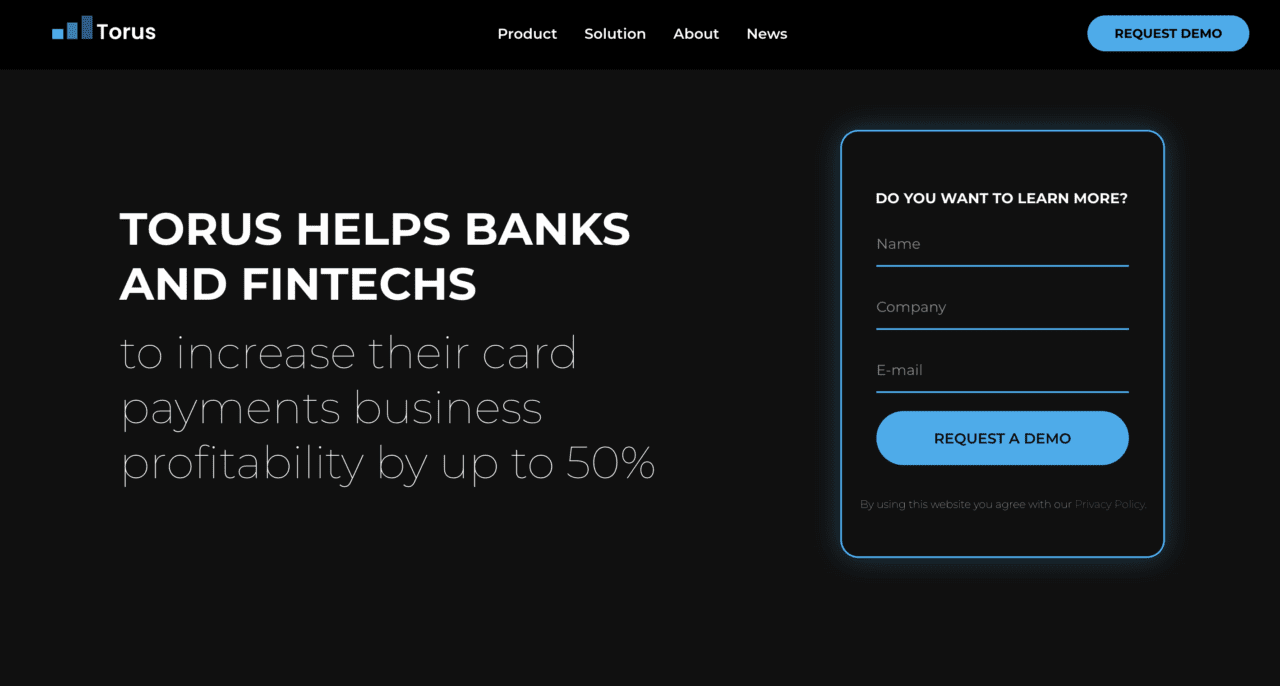
This week, Finovate Global travels to Lithuania to talk about payment card optimization with Torus’ Kirill Lisitsyn.
The payment card business is among the most competitive areas of financial services. But are some of the greatest opportunities for companies to profit being overlooked? A growing number of fintechs have developed strategies and technologies to help card issuers and acquirers access millions of dollars in cost savings and missed revenue by better controlling card network fees and enhancing transactional profitability.

Lithuania-based Torus is one such fintech. Founded in 2021 and making its Finovate debut at FinovateEurope 2024, Torus offers a SaaS intelligence platform for banks and acquirers that enhances profits on card transactions by up to 50%. The company enables card issuers and merchant acquirers to optimize card scheme fees and boost transactional earnings via pricing optimization and profitability analysis at the card and merchant level.
To discuss this field, and the opportunities it presents for card issuers and merchant acquirers, we caught up with Torus Co-Founder and CEO Kirill Lisitsyn (pictured). Lisitsyn brings to bear more than 15 years of experience leading payments consulting projects at firms such as Accenture and Mastercard.
Torus most recently demonstrated its technology on the Finovate stage at FinovateEurope in February.
What problem does Torus solve and who does it solve it for?
Kirill Lisitsyn: Torus is a SaaS platform for in-depth analysis and optimization of scheme fees (Visa, Mastercard) for issuers, merchant acquirers, and now large merchants. We automate the collection, forecasting, and reconciliation of both transaction flows and invoice data, so that our clients can see accurate cost and profit metrics at the level of transaction, product, merchant, region—and beyond.
How does Torus solve this problem better than other companies or solutions?
Lisitsyn: We provide nearly 98% fee prediction accuracy, and our plug-and-play setup enables end-to-end analytics with minimum resources needed from the customer side. Torus goes beyond pretty dashboards to deliver optimization recommendations backed by industry benchmarks and detailed “what-if” simulations.
Who are Torus’ primary customers. How do you reach them?
Lisitsyn: Our clients include banks, fintechs, BaaS providers, PSPs, and large merchants across Europe, the UK, Central Asia, and Japan. We reach them through targeted outreach, industry conferences, high-visibility publications, and strategic partnerships with top-tier industry players.
We’re also building a community around card economics. I run a LinkedIn page where I share insights on scheme fee mechanics, analysis pitfalls, and market updates.
Many clients come to us after seeing just one number: $1M+ in annual losses that could be avoided with better visibility.

Can you tell us about a favorite implementation or deployment of your technology?
Lisitsyn: One EU-based e-commerce acquirer used to assess profitability by portfolio averages—and was losing up to 10% on hidden merchant-level losses. With Torus, they switched to granular analysis, identified low-margin segments, updated pricing, and increased overall portfolio margin by 30%. These are real, realized gains—not slideware.
What in your background gave you the confidence to tackle this challenge?
Lisitsyn: We have productized over a hundred years of joint team expertise in the card payments industry—coming from different segments of the industry, players like Mastercard, Global Payments, Societe Generale, Worldline, and various other banks. This is our unfair advantage which gives us a deep understanding of where the pain points are. When your team includes former scheme insiders, “scheme fees” stop being scary and start becoming manageable.
What is the fintech ecosystem in Lithuania like? What is the relationship between fintechs, banks, and traditional financial services companies in Lithuania?
Lisitsyn: Lithuania is a magnet for fintech startups: a responsive regulator, fast-track licensing, and tech-forward infrastructure. Banks here are increasingly open to partnerships, and startups are learning to scale responsibly and operate under real-world pressures.
Torus is a great example of how legacy banking know-how and fintech velocity can combine into something powerful. We are proud to both actively contribute to the Lithuanian ecosystem and represent it internationally.
You demoed at FinovateEurope earlier this year. How was your experience?
Lisitsyn: This year we demoed our product for BaaS providers. We showcased how Torus enables these players to accurately calculate scheme fees and interchange per transaction, allocate costs, and build margin-based pricing for their fintech partners.
We demonstrated that BaaS can move beyond volume games and become a margin game.
Finovate is built for showing working products to real decision-makers—and our demo generated several highly relevant inbound requests for our BaaS module.
What are your goals for Torus? What can we expect to hear from you in the months to come?
Lisitsyn: We’re scaling fast. This year includes multiple product launches and major feature updates. Just a month ago, we released our new product, Merchant Cost Indicator—a tool that estimates transaction costs without needing real data. It predicts interchange and scheme fees based on country, MCC, and channel, giving acquirers and BIN sponsors instant, reliable margin calculations.
Coming next is a dynamic profit-based pricing module, embedded analytics for BaaS, and AI agents to support profitability control, pricing and decision workflows.
We’re shaping a new standard of transparency and profitability controls in card economics. Our strength lies in combining deep industry expertise with true product velocity. We know where the market is heading—and we’re already moving to clear the path.
Here is our look at fintech innovation around the world.
Latin America and the Caribbean
- Brazilian digital banking company Nubank introduced Tap-to-Pay Pix.
- Bloomberg looked at ways the Mexican government can help support the country’s fintech industry.
- Fiserv announced plans to acquire Brazilian fintech Money Money.
Asia-Pacific
- The Stock Exchange of Thailand announced deployment of risk and surveillance platforms courtesy of its expanded strategic technology partnership with the Nasdaq.
- Adyen selected Fiskil as its data-sharing partner to enhance onboarding and account verification for merchants in Australia.
- Vietnam-based securities company Kafi went live with Horizon Trading Solutions.
Sub-Saharan Africa
- African proptech Nawy secured $52 million in Series A funding.
- Payment solutions provider Cross Switch partnered with Pesawise to bring its services to Kenya.
- Harvard Business School reported on the impact of microlending in Kenya.
Central and Eastern Europe
- German fintech Pliant announced $40 million in Series B funding to support its expansion to the US.
- Raiffeisen Bank teamed up with Wise Platform to enhance cross-border payments to customers in Central and Eastern Europe.
- Berlin-based expense management platform Circula raised €15 million in an extended Series A round.
Middle East and Northern Africa
- Israel-based BioCatch and The Knoble co-launched an anti-scam guide and cost calculator.
- MENA-based virtual assets trading platform BitOasis expanded to Bahrain.
- The government of Dubai partnered with Crypto.com to enable crypto payments for government fees.
Central and Southern Asia
- Forbes profiled Razorpay co-founder Harshil Mathur.
- Pakistani fintech ABHI partnered with UAE-based LuLuFin to enhance financial inclusion and remittance solutions.
- Indian fintech unicorn Moneyview readies for an initial public offering.
Photo by Maksim Shutov on Unsplash